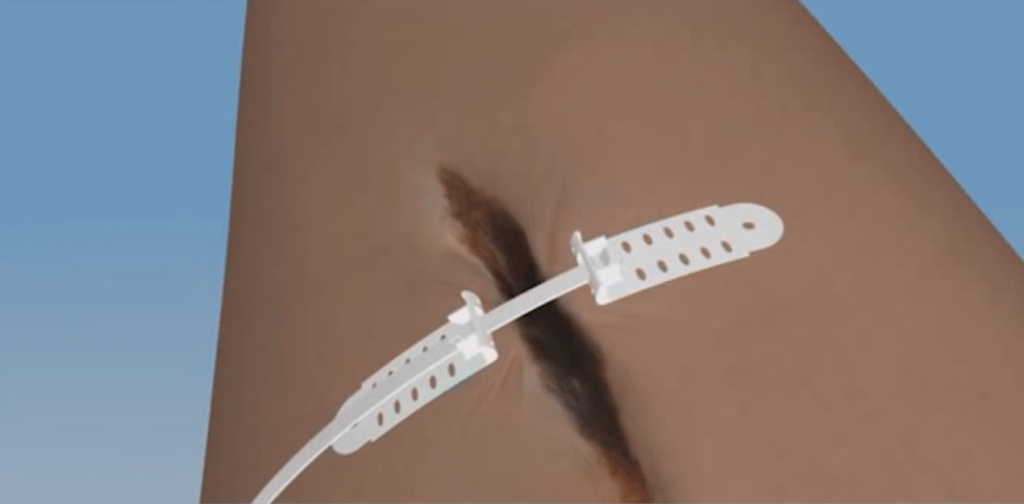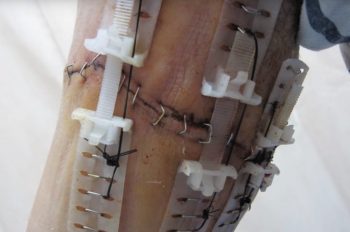Surgical suturing, commonly known as stitching, has been used for sealing wounds closed as far back as 3000 BC in Ancient Egypt. Since then, this medical technique, using a needle to sew two flaps of skin together, has saved patients recovering from injuries or surgery. But it has remained fundamentally unchanged in the past five millennia.
Four years ago, TopClosure, a mechanism that aids the closure and healing of post-traumatic, surgical, acute and chronic skin wounds, burst onto the scene and generated international headlines. Now, this innovative Israeli-invented device is being used in vital organ surgery to save lives, allowing for speedier recoveries and reducing the risk of infection.
TopClosure was invented by Dr. Moris Topaz, chief of plastic surgery at Hillel Yaffe Medical Center in Hadera. The product contains two clasps adhered to the skin on either side of a wound connected by a cable that tightens, sealing the open wound. Used by medical professionals in hospitals, it works by first stretching out the skin around the wound to avoid the need for skin grafts, and second, by ensuring that the wound scars properly. This procedure mitigates disadvantages of traditional stitching methods including high tension on the skin, difficulty of application and skin aesthetics following recovery.
Made with a special polymer that’s been tested to be durable and supportive for suture, TopClosure is specifically designed to collapse just before too much tension starts tearing skin tissues, as stitching big wounds may do. The unique method is likely to improve the current suture practice significantly: it can be used before surgery to prepare the skin incisions, during surgery to relieve tension on the skin, and after surgery as additional fastening support along with stitches.
SEE ALSO: Israeli-Developed Bandage That Stops Bleeding Within Seconds Now Sold Globally
Dr. Topaz tells NoCamels in a phone interview that TopClosure’s most exciting recent developments are in new applications to more complex wounds, going beyond skin injuries.
“Our main achievements are in the application of TopClosure in providing ground-breaking solutions for soft tissue injuries, open abdomen in trauma, deep sternal wound infection in cardiothoracic surgery, and tissue pressure injury,” Topaz says.
Israel’s largest children’s hospital, the Schneider Children’s Medical Center in Petah Tikva, adopted TopClosure in 2016. Dr. Michael Gurevich, a liver transplant surgeon at the hospital, highlighted that the technology has already allowed speedier recoveries from abdominal cavity surgeries.
According to Gurevich, prior to TopClosure, it was difficult to seal wounds following liver transplants because the new organ may occupy more volume than the abdominal cavity. This led to risks such as infection caused by internal organ exposure.
“If you don’t close [the wound] in the short term, you will lose the child,” Gurevich tells NoCamels. With TopClosure, “we can close very big wounds bit by bit every few hours. Before this device, it was impossible,” he adds, noting that the product has already been applied in seven liver transplant cases.
The TopClosure kits come in different sizes, 4mm and 8mm, with a 6mm version in a hospital pack of three, TopClosure’s TRS 3S. There are also separate waterproof, durable kits for use in civilian emergency scenarios and in military situations, as well as a veterinary pack for animals.
Gurevich stressed the economic and time benefits of the product. “You can save a lot of time on [patient] hospitalization, surgery, and antibiotics, as well as materials like meshes and skin grafts.”
TopClosure is “an absolutely new innovative technique [with] 100 percent success rate,” he says.
In addition to increased applications, Topaz also highlighted the growing number of countries that now use TopClosure in their hospitals, including China and Kenya.
Sign up for our free weekly newsletter
Subscribe“We’ve brought this technology to China and Israel. Now we’re spreading it to Africa because this is where it really matters,” Topaz says. “This is crucial in Africa and other developing countries [where] antibiotics are rather limited.”
Notably, Topaz lectured in Kenyatta University in Nairobi, Kenya, where he hopes leading medical professionals in the country will be able to diffuse the innovation. Topaz did not disclose any figures relating to the financial success of TopClosure.
Optimizing surgical procedure with TopClosure using vacuums
Another exciting development in Topaz’s work is Vcare α (pronounced Vcare alpha). Developed by IVT Medical, the parent company of TopClosure founded by Topaz, Vcare α is a suction device that removes infectious materials and excess bodily fluids including blood and pus from wound cavities. According to the official website, this optimizes the wound environment for surgery and accelerates wound recovery.
Though similar vacuum suction devices such as Medela exist, Topaz says his device is the first of its kind that also applies oxygen-enriched and irrigation negative pressure-assisted wound therapy (ROI-NPT) – a process that prevents infections through negative pressure and increased oxygen levels in the treatment area. This technique was pioneered by Topaz, who tells NoCamels that increased oxygen exposure reduces infection risk and expedites wound closure.
In particular, Topaz highlights that Vcare α works in synergy with TopClosure, combining “the treating and the closing of the wound together.” The vacuum system first removes excess fluids from wounds, and TopClosure is then applied to seal the wound.
“It’s a combination of TopClosure and the special vacuum system that we developed. That creates an atmosphere that allows us to stretch the skin and close the wound in a very short time,” Topaz says of the effectiveness of the system.
What’s next?
Given the conservative nature of the medical field, TopClosure and VCare α are yet to be adopted widely as the standard procedure for wound closure, according to Topaz. Though the product’s application has grown since 2014, Topaz hopes that his team can facilitate a greater worldwide awareness for the product.
SEE ALSO: Israeli Startup Aims To Bring Health Tech To The World’s Most Remote Areas
“The main challenge is how to bring this technology to the attention of doctors and patients…there are so many places in the world where this technology would be crucial,” he says.
Topaz believes that training doctors to use this technology and observe its benefits are vital toward its success. Topaz stated, “The main issue is training the setup of minds, doctors and the medical community because we are doing things we never have done before.”
According to Topaz, another crucial step in spreading TopClosure’s solutions is educating medical students. “It should start at this level. We are changing the fundamentals of wound closure. This would change the future,” Topaz claims.
Related posts

Editors’ & Readers’ Choice: 10 Favorite NoCamels Articles

Forward Facing: What Does The Future Hold For Israeli High-Tech?

Impact Innovation: Israeli Startups That Could Shape Our Future






Facebook comments